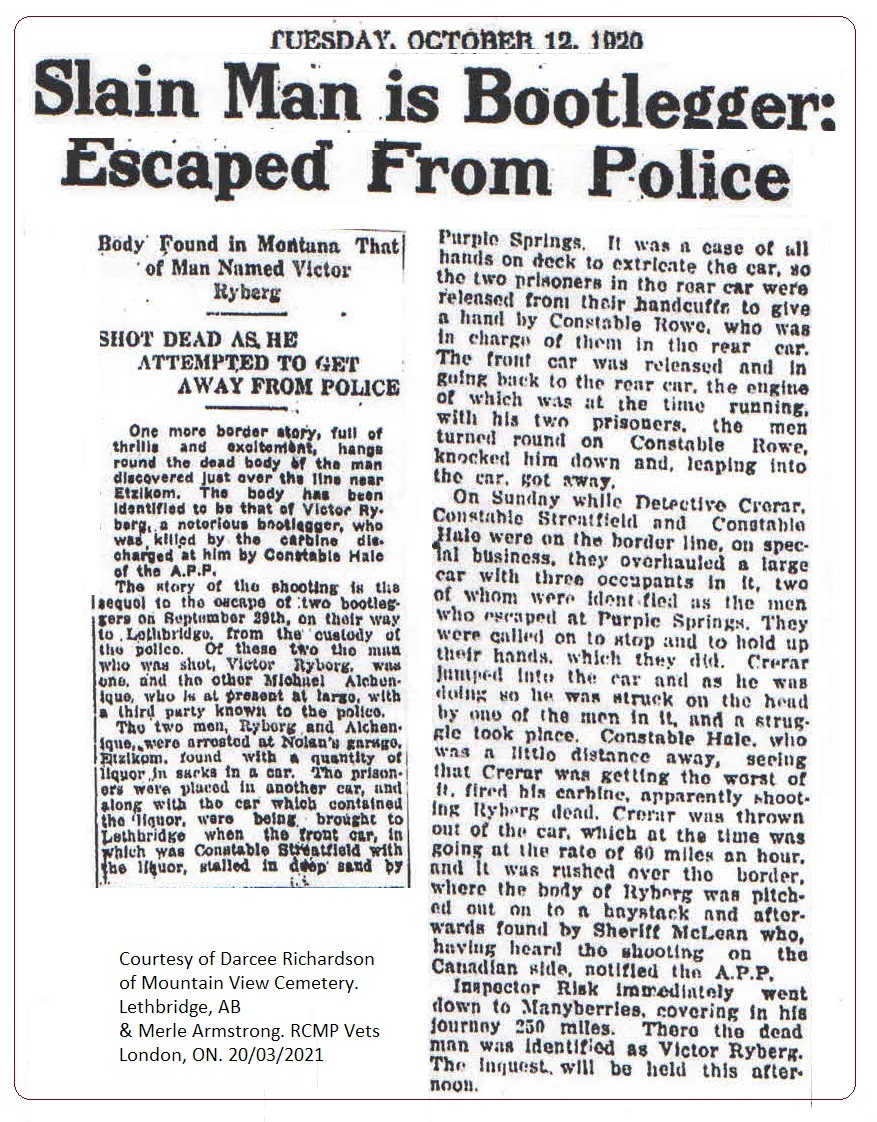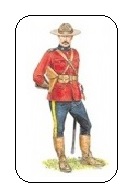True and Fascinating Canadian History
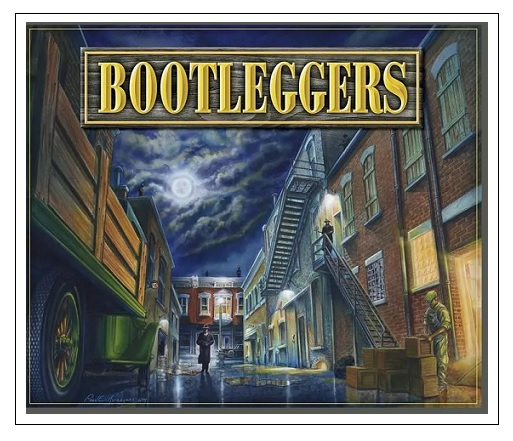
A Mystery of the Mounties:
And The Costly Price Paid For Profit
by J. J. (Joe) Healy. RCMP Veterans. Ottawa, ON
I am very appreciative to my very good friend RCMP Veteran Merle Armstrong of London, ON for sending me this story about Reg.#7056, RCMP Constable Ray Victor Rydberg. Merle discovered the details of Constable Rydberg's life while researching on-line for the graves of deceased Canadian soldiers.
While growing up, Ray Victor Rydberg was reputed to be an honourable, good natured young person, but like thousands of returning soldiers, WWI apparently took its toll on his mental capacity and his personality was affected but not for the better. It may forever be a mystery why Constable Ray Victor Rydberg turned to shady characters to make friends after his return to Canada from Europe, and the reasons for him to enter into unlawful business affairs are also a mystery. The net results of his crime spree turned out to be highly unprofitable, and his death at a very young age was unexpected, sad, sudden and tragic.

Ray Victor Rydberg was born in Blanchard, Iowa, USA on May 13, 1896 to Emil and Jennie Rydberg. His mother died in 1901 and his father decided to move to Alberta in 1904 along with his two boys; the eldest Roy Weldon Rydberg and Ray Victor Rydberg. In 1907, their father married a Canadian woman, and soon the Rydberg family discovered that life was as equally difficult and uncertain in Canada as the life they had left behind in Iowa. WWI was on the distant horizon.
At the outbreak of WWI, Roy Rydberg enlisted into the Canadian Expeditionary Force (CEF) and not long afterwards he was killed in Belgium. It was 1915. The loss of his older brother had a huge impact on Ray, and Roy's death may have been the start of Ray's bitterness towards life. Nevertheless, an April 27, 1918, at the age of twenty-one, Ray joined the RNWMP and soon afterwards, on May 1, 1918, he too joined the Canadian Expeditionary Force (CEF) as part of A Squadron -- the RNWMP Calvary Draft. Ray Victor Rydberg was assigned Service #2684087 and he went on to serve honourably in Canada, England and France. On January 21, 1919, he was demobilized in Calgary, AB at the army rank of Corporal. The reason for him not to return to the RNWMP is not known.
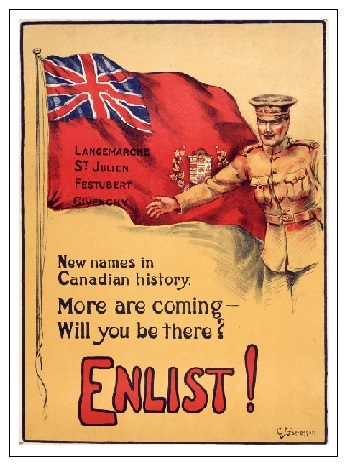
After the war, Ray's father and his step mother related to friends that Ray had once been a quiet and well behaved young man, but upon his return from overseas, he changed. He became restless and argumentative. Ray soon fell in with a gang of bootleggers in Sweet Grass, Montana. On the US side of the border prohibition was in full swing, but on the Canadian side there was easy money to be made. And lots of it. If one had the right friends.
His parents worried about Ray's new found friends who were considered unreliable, and they surmised that Ray was heading for trouble. Oftentimes he did not return home. Through his shady friends, Ray was introduced to unscrupulous ways of turning a profit -- the scheme had everything to do with bootlegging. And, of course, a profit. It wasn't long before Ray was known as a “notorious bootlegger”, and soon Ray's name came to the attention of the Alberta Provincial Police (APP). Ray Victor Rydberg had successfully made it to the top of the list of suspects in the bootlegging business. But, in bootlegging, no one stayed on top too long. The APP made sure of it.
On September 29, 1920 two police cruisers of the Alberta Provincial Police (APP) were on patrol in Etzikom, a small hamlet in the southern part of the province. The APP spotted Rydberg in a car with another man. Upon stopping and searching Rydberg's car, the APP discovered a fair quantity of liquor partly hidden under cloth sacks in the trunk. The pair were promptly arrested for possession of illegal contraband. The two suspects were handcuffed and placed in one of the police cruisers, however, the second APP cruiser became stuck in the boggy road. To solve the problem, the APP needed muscle to free the cruiser from the mud, and for just a few minutes the APP let their guard down.

The APP removed the handcuffs from Rydberg and the second suspect so that the two prisoners could assist and dislodge the cruiser stuck in mud. The coordinated push was successful to free the cruiser, however, before the pair could be handcuffed, they knocked one of the APP to the ground and they escaped in the cruiser which had been left with its keys in the ignition. Rydberg and his pal made good their escape. A wanted bulletin was broadcast by the APP. Former Constable Ray Victor Rydberg was a wanted man.
A few weeks later, on October 9, 1920, three APP constables were on patrol near the Canada / US border. They spotted a vehicle with three male occupants. To the APP, the trio looked suspicious. One of the APP recognized two occupants of the vehicle to be the same suspects who had escaped previously at Etzikom. The trio complied when the APP ordered them to stop. One of the three suspects in the car was identified as Ray Rydberg.
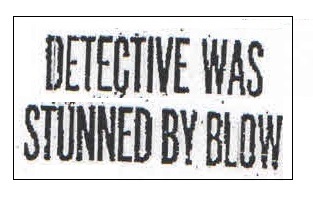
Detective Crearar of the APP climbed into the back seat with his rifle to search the interior of the car, but he was immediately struck in the head by one of the suspects. In the ensuing struggle, Crearar was overpowered. The suspects then sped off towards the US border at speeds estimated to be near 60 miles per hour. The car frequently zigzagged from one side of the road to the other. Detective Crearar continued to struggle. His own carbine was pressed against his forehead with such force that it caused abrasions to the bridge of his Crearar's nose. The speeding car was fast approaching the US/Canadian border.

The offending vehicle sped along the highway to the Q Ranch. Meanwhile, Constable Hale of the APP realized what was happening to Detective Crearar so he set up a roadblock. He crouched on his knees with his own carbine, and as the suspect's car approached, Constable Hale fired his rifle in an attempt to stop the car and to free Detective Crearar. However, his aim was off, and the bullet struck Ray Rydberg in the heart. He fell limp onto the lap of Detective Crearar. Ray Rydberg was dead. He was 24 years of age. In the midst of the havoc, Detective Crearar's carbine dropped to the floor of the car but another suspect picked it up and flung the rifle out the car window. Somehow Detective Crearar escaped the vehicle and the two suspects, with Rydberg’s lifeless body still in the car, successfully crossed the border and into Montana. The suspects discarded Ray Rydberg’s body by tossing it on top of a hay stack in Montana. Later, his corpse was found by a US Sheriff McLean.
After the discovery of Ray Rydberg's body, Sheriff McLean notified the APP. Two members of the APP went to Montana in order to retrieve Rydberg’s remains for the Coroner's Inquest, however, the APP's request was denied as US authorities claimed that Rydberg was a US Citizen. Rydberg’s father and step-mother were notified of their son's death. They drove to Montana where they positively identified their son and advised US authorities that he was a Canadian citizen and that he had served in the CEF during WWI. The US Marshall's Office released Rydberg's body to his parents.

In a subsequent Coroner’s Inquest, Cst. Hale of the APP was exonerated for shooting Ray Victor Rydberg. The Coroner concluded that Rydberg's death was a direct result of the events which took place between he and the other suspects and the APP. Ray Rydberg had little time to benefit from the profits of his bootlegging enterprise.
Ray Victor Rydberg was buried in Mountain View Cemetery in Lethbridge, AB. He lies in an unmarked grave.
Appreciation: The newspaper accounts from the Lethbridge Herald and Wainwright Star were kindly provided to Veteran Merle Armstrong by Darcee Richardson of Mountain View Cemetery. And I thank them for sharing them with me.
Reporting from Fort Healy,
J. J. Healy
March 24, 2021
